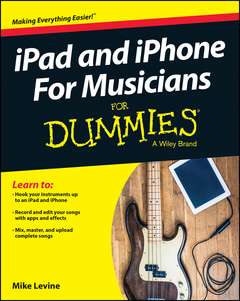Description
iPad and iPhone For Musicians For Dummies
Authors: Williams Ryan C., Levine Mike
Language: English
Subject for iPad and iPhone For Musicians For Dummies:
Keywords
iPad and iPhone For Musicians For Dummies; Mike Levine; iPad and iPhone For Musicians; iPad; iPhone; iPhone For Musicians; iPad for Musicians; GarageBand; IK Multimedia; music app; music apps; music apps and hardware; music apps and hardware accessories; AmpliTube; AudioBus; master your own music; record and master your own music; portable musical instruments; recording apps
Approximative price 31.03 €
In Print (Delivery period: 12 days).
Add to cart408 p. · 18.8x23.4 cm · Paperback
Description
/li>Contents
/li>Readership
/li>Biography
/li>
If you are a budding or established musician looking to use your iPad or iPhone as a portable musical instrument, recording studio, or composition tool, then you?ve come to the right place! iPad and iPhone For Musicians For Dummies explains in plain English how to hook up your preferred instrument to your iPad or iPhone to work on music projects within a plethora of recording apps. You?ll also learn how to incorporate both real and MIDI instruments and audio, edit individual tracks, work with effects and chain multiple apps together, and mix and master songs.
Thanks to apps such as AmpliTube, AudioBus, and Apple?s own GarageBand, musicians can record entire songs in the comfort of their own homes and then mix, master, and distribute them right there on their iPads or iPhones. Packed with tons of step?by?step instructions, this friendly guide shows you how to use your device to go from recording a basic piece of music to creating and uploading complete songs with full instrumentation and multiple tracks, instruments, and effects.
- Demonstrates how to hook up your guitar or keyboard directly to your iPad or iPhone to record professional?grade tracks
- Helps musicians get the most out of their iPads or iPhones as portable musical instruments, recording studios, and composition tools
- Written by an industry expert and former senior writer for IK Multimedia, a leading manufacturer of music apps and hardware accessories for the iOS market
- Coverage goes beyond GarageBand to include other popular technologies
Don?t let the limitations and expense of yesterday?s home studios keep you from recording awesome music?let iPad and iPhone For Musicians For Dummies show you how easy it is to record and master your own music right from your living room.
Introduction 1
Part I: Getting Started with iOS Music 5
Chapter 1: Digging into iOS 7
Chapter 2: Choosing Your iOS Device 17
Chapter 3: Downloading Apps from the iTunes Store 25
Part II: Playing Music on Your iOS Device 41
Chapter 4: Exploring iOS Instruments 43
Chapter 5: Playing iOS Instruments 73
Chapter 6: Playing Your Guitar or Bass through Your iOS Device 87
Chapter 7: Connecting Your Mic to Your iOS Device 111
Chapter 8: Performing with Your iOS Device 123
Part III: Setting Up Your iOS Studio 137
Chapter 9: Planning Your Rig 139
Chapter 10: Working with Digital Audio Workstations and Other Recording Apps 153
Chapter 11: Monitoring with Speakers and Headphones 183
Part IV: Your Recording Workflow 195
Chapter 12: Recording Live or Layered? 197
Chapter 13: Getting the Best Recording Quality 211
Chapter 14: Recording in the Field 223
Part V: Using Multiple Apps Together 235
Chapter 15: Working with Multiple Apps Together 237
Chapter 16: Using Inter–App Audio 249
Chapter 17: Using Audiobus 259
Chapter 18: Other Multi–App Possibilities 279
Part VI: Editing, Mixing, and Sharing Your Projects 303
Chapter 19: Editing Your Material 305
Chapter 20: Mixing Your Music 325
Chapter 21: Exporting Your Finished Masterpiece 345
Part VII: The Part of Tens 357
Chapter 22: Ten Music Apps You Can’t Live Without 359
Chapter 23: Ten Great Free Music Apps 363
Chapter 24: Ten Other Musical Uses for Your iOS Device 367
Index 371
What is it: The introduction of Garageband in 2005 pushed the iPad into the world of mobile recording. The global spread of the Apple device, along with the smaller iPhone, has put recording technologies into the hands of amateur musicians worldwide at lower costs than traditional recording tools. A broad ecosystem of apps and hardware has grown from the introduction of Garageband to the point that an iPad can serve as the sole recording device for a pro–level musician. |
Ryan C. Williams is a musician and an expert on digital music tools. He is author of Teach Yourself Visually Bass Guitar as well as books on digital music, podcasting, and online business. Mike Levine is U.S. editor for Audiofanzine and a former editor for Electronic Musician.

